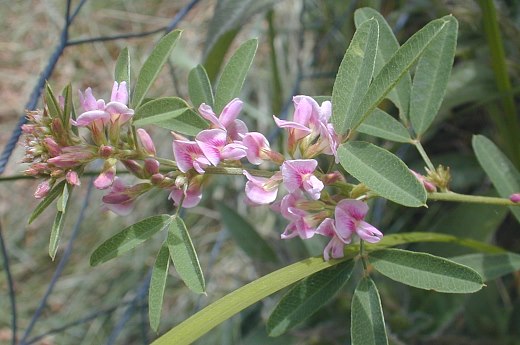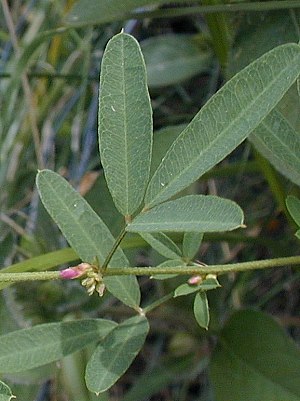Description: This perennial plant is sparsely branched and up to 2½' tall. The stems have fine white hairs. The alternate compound leaves are trifoliate and have slender primary petioles about ¼–¾" long. The leaflets are up to 1½" long and ½" across. They have smooth margins and are oblong, except for a tiny point at the tip.

The flowers occur
in crowded heads on short peduncles in the upper portions of the stems.
The lower flowers are cleistogamous and inconspicuous; they are capable
of forming fertile seeds without the pollination of insects. The upper
flowers are about ¼" across and have a typical pea-like structure. This
consists of a broad upper petal, and two smaller side petals that
parallel a jutting lower lip. The petals of these flowers are pink,
although the base of the upper petal is rose pink. These flowers remain
clustered along the stems amid the leaves. The blooming period is late
summer or early fall, and lasts about 3 weeks. There is no floral
scent. The root system consists of a deep taproot.
Cultivation:
The preference is full or partial sun, and mesic to dry conditions.
This plant grows readily in soil that is loamy, rocky, or sandy. It has
excellent drought resistance. It's easy to start plants from seeds or
transplants, and foliar disease is rarely troublesome. Soil with below
average pH is tolerated, if not actually preferred. Sometimes this
plant has trouble competing against taller, more aggressive plants in
fertile soil.
Range & Habitat: The
native Slender
Bush Clover is occasional in the southwestern section of Illinois, but
it is
uncommon or absent elsewhere (see
Distribution Map).
Habitats include drier areas of black soil and sandy prairies, hill
prairies, rocky upland forests and sandy forests, savannas and sandy
savannas, scrubby barrens with poor soil, limestone glades, bluffs, and
banks along lakes. The woodland areas where this plant occurs are often
dominated by oak trees.

Faunal
Associations:
The flowers are visited by long-tongued bees, short-tongued bees,
flies, small butterflies, and skippers. These insects seek nectar,
although the bees also collect pollen. Among these visitors, bees are
probably the most effective pollinators of the flowers. The
caterpillars of some species of skippers feed on the foliage, including
Thorybes bathyllus (Southern Cloudywing), Thorybes
pylades (Northern Cloudywing), and Achalarus
lyciades (Hoary Edge). The seeds are eaten by some upland
gamebirds, particularly the Bobwhite, and occasionally the Wild Turkey.
Mammalian herbivores of all kinds readily feed on Slender Bush Clover,
including deer, rabbits, groundhogs, and livestock. An overpopulation
of these animals can make the establishment of this plant difficult in
some areas.
Photographic Location:
The photograph was taken at the webmaster's wildflower garden in
Urbana, Illinois.
Comments:
The flowers of Slender Bush Clover are attractive, but small-sized.
This plant has a more delicate appearance than Lespedeza
capitata (Round-Headed Bush Clover), with greener leaves and
pinker flowers.